By Lars Kjellberg
35 mm, medium format, or large format? A large format negative does not have to be enlarged as much as a 35 mm negative, and the results are therefore much sharper. Most photographers would agree on that. However, our test shows that 35 mm can be almost as sharp as large format, if you take the photographs correctly and choose the right film.
By Lars Kjellberg We will analyse what happens to the focus both in a negative and the final print when using 35 mm, medium format, and large format.
The same perspective regardless of format
Let us begin by looking at the optical image projected onto the film in the camera; an image whose quality is limited by the lens' quality and optical construction, and by the laws of diffraction.
Imagine an object that is going to be reproduced with a certain perspective. We are going to photograph it using three different formats (24x36 mm, 6x6 cm, and 9x12 cm). The normal focal length corresponds to the diagonal of the negative size. The perspective we acquire when using a normal lens is the same perspective that we see when we look at the object with the naked eye. The relationship in size between close and distant objects is the same in reality as it is in the picture. The normal focal length for 35 mm film is 50 mm, for medium format 80 mm, and for 9x12 cm approximately 150 mm.
The tests we ran to make these comparisons were all done with the object placed in the centre of the picture. The MTF was measured in the centre of the picture, and the objects photographed are placed in the middle of the negative.
Unchanged depth of field
We first determine what depth of field we desire and thus the working aperture. Depth of field was discussed in detail in an earlier article, in which it was argued that depth of field is a question of definition. How blurred can the image be away from the plane of focus before it becomes unacceptable? With larger formats we can tolerate a reduced sharpness without getting an blurred final image. The negative -and hence any blur - is not enlarged as much with large format film. We have assumed that the result will be pictures of the same size regardless of what negative format we used.
A larger negative demands a longer focal length to reproduce a scene with the same perspective. A longer focal length with a given aperture will give a shorter depth of field. Therefore the longer focal length has to be stopped down further to keep a satisfactory depth of field. If you do the calculation, you will find that in principle you retain a given depth of field if you increase the aperture by the same factor as you increase the focal length. The 150 mm used for large format is three times longer than the 50 mm used on 35 mm cameras. The depth of field you get at 50 mm stopped down to aperture 8 is the same as when using a large format normal focal length 150 mm when it has been stopped down to f22 (150/50 = 3, 3 x f8 = 24 = f22).
With this standard reasoning - where the acceptable level of blurring (circle of confusion) varies with the film format - the difference in sharpness between the focal plane and the outer edges of the circle of confusion becomes greater when using a larger format. If demand higher performance from the larger formats, we have to stop down a bit further. In our test we chose to stop down 6x6 two stops and 9x12 four stops compared to 35 mm. For example, f5.6 for 35 mm, f11 for medium format, and f22 for large format.
Four evaluations
We have looked at four different things:
1. The MTF of the lens at the appropriate aperture. We measured this using Hasselblad's MTF-equipment in Gothenburg, Sweden.
2. The MTF for different films. We have worked from the data sheets provided by the film manufacturers, assuming that their curves are reliable, and that they were made according to a consistent standard.
3. We have calculated the MTF for the combination of stopped-down lens and film, using the data sheets for the MTF of the lens and the film.
4. Finally we took photographs using the three formats, stopping down to the appropriate aperture and using two different films, and then analysed the pictures under a microscope to check the sharpness.
The MTF of the lenses
The lenses we chose to use in this test are a Carl Zeiss Planar T* 50/1.4 for 35 mm, a Carl Zeiss Planar 80/2.8 (Hasselblad) for 6x6 cm, and a Rodenstock Sironar 150/5.6 for 9x12 cm.
The MTF measurements were made with at different apertures for each lens: Planar T* 50/1.4 at f2.8 and f5.6; Planar 80/5.6 at f5.6 and f11; and Sironar 150/5.6 at f11 and f22.
In the diagram we have taken into account the fact that a 6x6 negative is not going to be enlarged as much as 35 mm, and that 9x12 is not going to be as enlarged as much as 6x6. The diagram shows the MTF at line frequencies 0, 10, 20, 30, 40, and 50 lp/mm for 35 mm, 0, 6, 12, 18, 24 and 30 lp/mm for 6x6 cm, and 0, 3, 5, 8, 11 and 14 lp/mm for 9x12 cm.
If you stop down heavily - i.e. when you want to achieve a large depth of field - the lenses are principally limited by diffraction. The longer the focal length, the smaller the aperture, so you get higher diffraction and worse sharpness in general. However, the loss of sharpness you get with a large or medium format negative is compensated for by the fact that the negatives do not need to be enlarged as much.
The curves in Diagram 1 almost overlay one another. Here the lenses have been stopped down to apertures of f5.6, f11, and f22.
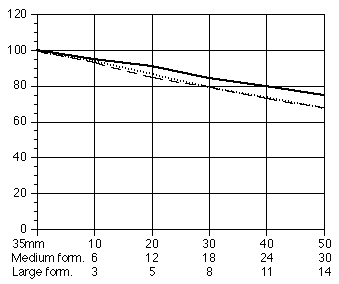
Sironar 150/5,6: solid line. Zeiss Planar 80/2,8: broken line. Contax Planar 50/1,4: dashed line.
With a shorter depth of field and wider apertures, we notice large format's superiority. Since the lenses are not just limited by diffraction at wide apertures - where they are also limited by their optical construction - the 35 mm is at a greater disadvantage than the medium and large format because of their low equivalent aperture settings.
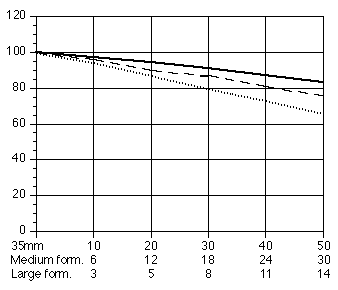
To conclude, with a wide aperture and short depth of field the sharpness is better with a larger format. When the lens is stopped down to get a deeper depth of field the difference between the different formats decreases. Above about f5.6 for 35 mm (f11 for 6x6 cm, and f22 for 9x12 cm) the difference in focus between the formats is insignificant. But this is only before we consider the film's effect on sharpness.
The MTF for film
Most film manufacturers issue voluminous data sheets for their products. They have lots of diagrams and charts that may seem incomprehensible and unnecessary. But to the initiated, they are a good source of information. Among other things the data sheets have MTF diagrams for the film. These diagrams are reminiscent of the lens MTF diagrams that show the MTF as a function of the line frequency. The big difference is that the film MTF at certain low line frequencies sometimes exceeds 100%, so the contrast is occasionally even greater after the picture has been projected on to the film. At a line frequency of zero (a surface with only a single colour) the MTF is always 100%. Then it rises above 100% before reaching a certain line frequency when it returns to 100% again. Thereafter the MTF continuously reduces as the line frequency increases.
Different films have different MTF. As a rule, black and white films have a higher MTF than colour films, because black and white film has only one layer of emulsion. As a rule you can also say that low speed film has a higher MTF than high speed, but this is only half of the story. Modern film designed with modern grain technology usually has a higher MTF value than an old film. Take for example the differences between Tri-X and T-Max. The MTF of T-Max 400 does not fall below 100% until about 35 lp/mm, and at 100 lp/mm the MTF is 50%. Tri-X's corresponding values are approximately 18 lp/mm at 100% and 30% at 100 lp/mm. T-Max 100 is even better than T-Max 400. It has an MTF of 100% at 50 lp/mm (which is impressive) and at 100 lp/mm the MTF is still 65%.
Another interesting comparison is slide film versus black and white. The super sharp ISO 50 film Fuji Velvia passes the 100% limit as early as 25 lp/mm and at 100 lp/mm it is down as far as 15% MTF. This film does not compare with T-Max when it comes to sharpness.
With the guidance of the curves it is easy to understand that the choice of film is a very important factor in the pursuit of sharpness. A low-grade lens will give decent pictures when combined with a sharp film, while the best lens will never do itself justice if there is an inferior film in the camera. Read the MTF diagrams and choose the right film for the best results!
The combined lens-film MTF
The next step in this test is to look at the combination of stopped down lens and film for the various formats. We have measured the MTF for all combinations. Using Tri-X the difference in sharpness between the different formats is substantial. Since we do not have to enlarge much when using the large format, we can make use of the Tri-X when it is at its best, at low line frequencies. With the smaller formats we end up among the high line frequencies and low MTF values. The difference is most apparent at wide apertures. The 35 mm negative is not able to reproduce the finer details of the subject. Medium format is much better, and large format is the best. This is how we imagined that the difference between the formats would be.
If we then look at what happens if we put T-Max 100 in the camera we are in for a surprise. The difference in resolution is not that great. With the lenses stopped down for an increased depth of field there is hardly any difference at all, and that is with the advantage of shutter speed that is a whole four steps shorter with the 35 mm. With a wider aperture the difference is greater, but it is still only marginal.
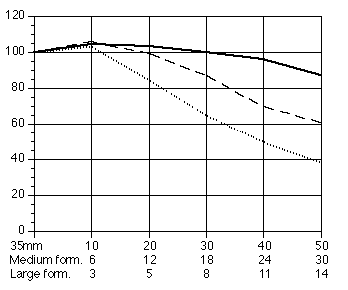
The three lenses stopped down to 11, 5.6 and 2.8, in combination with Tri-X film. There is a consideral difference in sharpness between the formats.
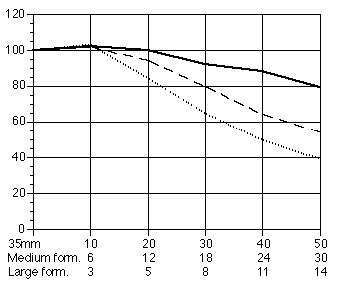
The same lenses but this time stopped down to 22, 11, and 5.6, with the Tri-X film. The difference in sharpness between the formats is slightly reduced.
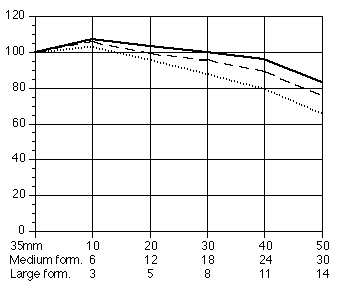
The lenses stopped down to 11, 5.6 and 2.8, in combination with T-MAX 100 film. There difference in sharpness between the formats is reduced even further.
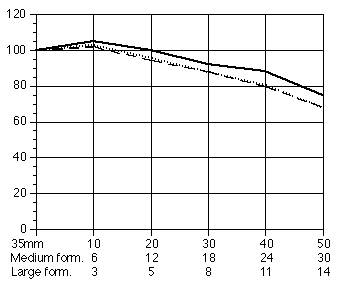
Now the lenses are stopped down for a greater field of view to 22, 11, and 5.6, with T-MAX 100 film. The difference in sharpness is almost gone.
Ilford do not publish MTF diagrams for their films, but it is probable that Delta 100 give similar negatives to T-Max 100.
Practical tests
Theory and data sheets are one thing, practical photography another, and of course we wanted to see what things looked like 'for real'.
To simplify the evaluation of the practical tests, we chose to photograph test patterns. The cameras were put on tripods and focused very carefully. The shutter was released either by self-timer or cable release. The negatives were photographed under a microscope, where the 35 mm negatives were enlarged 56 times, the medium format negatives 35 times, and the large format negatives 17.5 times. Any differences in size were corrected in the scanning process.
The result is astonishing at many levels. You may hope that theory and practice will be the same, but in this case we thought they would differ, if only slightly. To be honest we did not think the Kodak MTF T-Max 100 diagram could be right. A film couldn't be equally sharp in different formats! We were wrong!
T-Max 100 decisive
The first reaction when you see the results sorted and laid out on the table is that the T-Max is sharper than the Tri-X. This is hardly a surprise. What is surprising is that the difference is much more apparent in the smaller format than in the large format. A 35 mm T-Max negative is dramatically sharper than a 35 mm Tri-X negative. With the large format negatives it can a bit difficult to tell the Tri-X from the T-Max 100 at first glance.
The next thing you notice is the small difference between the formats when using T-Max 100. You see it, but it is not especially large. On the contrary, you can be very disappointed with the large format result; is there really not more difference than this?
And here is the big surprise: a 35 mm negative taken with the T-Max 100 is sharper than the large format negative taken with the Tri-X! Who would have thought it? It is important to add here that the small format picture was taken with a super sharp lens, the camera mounted on a tripod, and using a cable release; not exactly a free hand shot. But the large format picture was taken using the exact same technique. A 35 mm negative handled in the right way can be very clear, even when compared to large format.

Our test pattern was photographed with the cameras on a tripod, and with a wire release or self timer. The negatives were enlarged and photographed in a Nikon microscope. With the images 120 mm wide on the computer screen, the 35 mm negative is enlarged about 75 times.
1) Tri-X in a 35 mm camera with Planar 50/1.4 stopped down to f5.6. The sharpness is nothing you would like to brag about.
2) Tri-X in a Hasselblad with a Planar 80/2,8 stopped down to f11. Much sharper than the 35 mm.
3) Tri-X 9 x 12 in a large format camera with Sironar 150/5,6, stopped down to f22. It is even sharper than Hasselblad.
4) Now over to T-MAX 100. First 35 mm Contax with Planar 50/1.4 stopped down to f5.6. It appears sharper than the 9 x 12 cm Tri-X.
5) 6 x 6 with Planar 80/2.8 and f11 and T-MAX 100.
6) 9 x 12 with Sironar 150/5.6 at f22 and T-MAX 100. This image is the sharpest one, but the difference to 35 mm is suprisingly small.
7) The three smallest fields from Sironar and T-MAX 100 enlarged even further.
Different apertures
The practical tests were done using two different apertures: f2.8 and f5.6 with the 35 mm camera; f5.6 and f11 with medium format; and f11 and f16 with large format. It is hard to see the difference between them. With medium format and T-Max 100 you notice that f5.6 is sharper than f 11. Large format does not show any signs of loss in sharpness when stopping down to f22. It is only beyond f22 that the sharpness falls off noticeably. 35 mm is somewhat less sharp at f2.8 than f5.6, but not by much.
When it comes to grain, though, there is no comparison. The 35 mm is considerably more grainy than the large format, which is what you would expect. What is surprising is that the sharpness does not fall further than it does despite the grain.
Large format technique with a 35 mm camera
A lot of readers specialising in large format will react to this article with 'I know the large format is superior', and certainly you almost invariably get better results with a large format camera. But that could be for a number of reasons:
1. The large format camera is always mounted on a tripod. We avoid loss of sharpness caused by camera movement. Even a steady hand shakes enough to drag down the MTF values when shooting hand-held. For the best focus there is only one thing to do: use a tripod, mirror lockup, and a self-timer or cable release.
2. It is possible that when you are using a large format camera you do not always stop down to get the same depth of field that you do with a 35 mm camera. The shutter speeds become annoyingly long when the large format camera is stopped down to f45 or f64. You settle for a shorter depth of field. This is often noticeable in portraits taken from close distances. The depth of field is limited to the eyes and certain parts of the face at eye-level. The nose and ears are out of focus.
3. When using a large format camera you take photographs in a different way. You give yourself more time to compose the picture, and you use the film to its best advantage. Partial enlargements are not as common.
Sharper 35 mm pictures
With these three things in mind it is easy to improve the focus of 35 mm pictures considerably.
Mount the camera on a tripod!
Do not stop down too much!
Use the whole film area!
Do not forget that 35 mm gives you the advantage of shutter speeds up to three or four times faster than the 9x12 format. This means that you can use a film that is four stops lower in sensitivity, for example Agfapan APX 25 in a 35 mm camera compared with T-Max 400 in the large format camera. Because of the camera movements large format cameras usually don't have to be stopped down as far as I have indicated in this article. Tilting the camera front or back will give a sharp image on a larger aperture if you are shooting a plane object. Here we have the real advantage with large format cameras. Maximum sharpness at f-stops around 8 and 11, combined with a tilted front standard, can result in extremely sharp images of landscapes, with sharpness from the very close to the camera, all the way to infinity.
